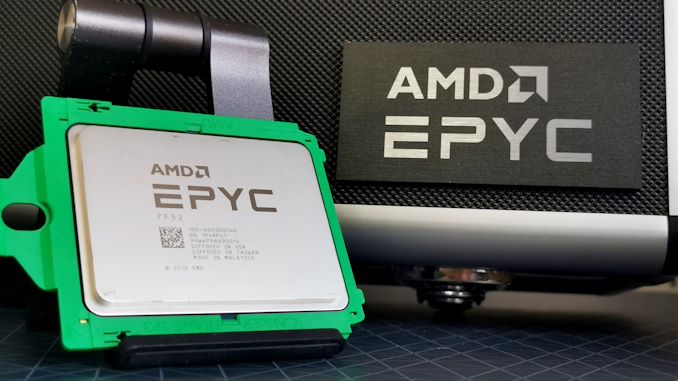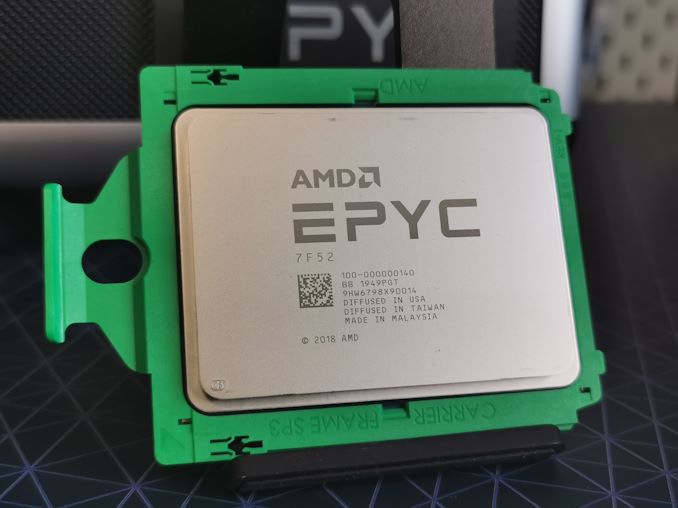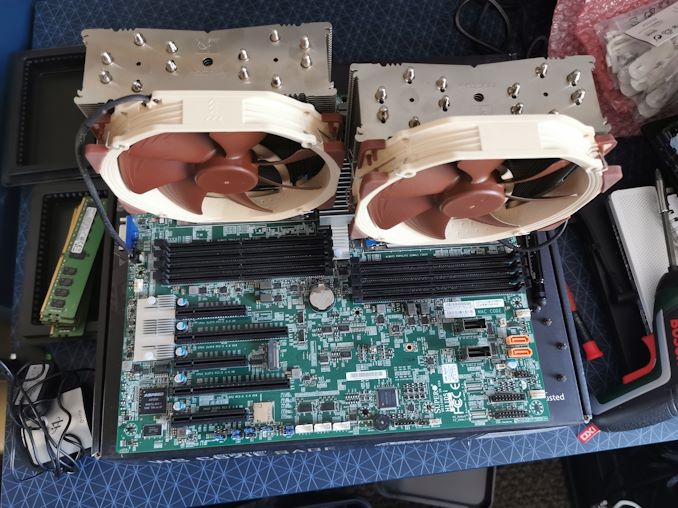AMD’s New EPYC 7F52 Reviewed: The F is for ᴴᴵᴳᴴ Frequency
by Dr. Ian Cutress on April 14, 2020 9:45 AM EST- Posted in
- CPUs
- AMD
- Enterprise
- Enterprise CPUs
- EPYC
- SP3r2
- CPU Frequency
- Rome
- 7Fx2

Everyone wants a fast processor. The ability to get more stuff done is one of a number of guiding principles of business. However, business also needs consistency, safety and security, which is why having enterprise-class processors is often a requirement in the back-end infrastructure. These processors, with lots of cores, aren’t as fast as consumer processors, so it becomes a tussle whether it makes sense to go fast without security, or to play it safe with a proven platform. With AMD’s new 7F processors, the aim is to provide that proven platform with super-fast cores with lots of cache. We’ve got the 7F52 in for testing today.
The Enterprise Market Wants It All
The nature of enterprise processors in recent generations has tended towards more cores and more cache. As power budgets have increased, in order to ensure stability and get the best efficiency points, the solution has been to add more cores. However, there are still markets that want high frequency components, and quite often users will look at consumer hardware, which doesn’t offer the trimmings of the enterprise world, such as ECC memory, RAS features, management, and high-speed IO. We’ve seen OEMs build servers on super rare ‘consumer-grade’ processors, like the auction-only 5 GHz 14-core parts that offer the peak of performance, but fall down on basic enterprise features, such as ECC memory.
To that end, AMD’s Enterprise division has been developing some high-frequency processors within its EPYC line of hardware to address this market. We saw with the first generation ‘Naples’ EPYC processors AMD come out with a special EPYC 7371 processor, which offered 16 cores but had +700 MHz on the base frequency and +900 MHz on the turbo frequency compared to the next best 16-core part, and the tradeoff was only +30 W of power and paying a bit extra. At the time the EPYC 7371, which was launched several months after the rest of the product line, was a test run for what is this new line of 7F ‘high frequency’ processors.
AMD 7F and 7H: Targeting High Performance
The best way to consider AMD’s EPYC processor line, especially for the second generation ‘Rome’ hardware, is in four segments.
First is the main stack. These are the regular processors for the majority of the market, from the 7252 with eight cores all the way up to the 7742 with 64 cores. These are all dual-socket compatible, and are anywhere from 155 W to 225 W (except the 7252 and 7262 which are 120 W).
| AMD EPYC 7002 'Rome' Processors (2P) | ||||||
| Cores Threads |
Frequency (GHz) | L3 | TDP | Price | ||
| Base | Max | |||||
| EPYC 7742 | 64 / 128 | 2.25 | 3.40 | 256 MB | 225 W | $6950 |
| EPYC 7702 | 64 / 128 | 2.00 | 3.35 | 256 MB | 200 W | $6450 |
| EPYC 7642 | 48 / 96 | 2.30 | 3.20 | 256 MB | 225 W | $4775 |
| EPYC 7552 | 48 / 96 | 2.20 | 3.30 | 192 MB | 200 W | $4025 |
| EPYC 7542 | 32 / 64 | 2.90 | 3.40 | 128 MB | 225 W | $3400 |
| EPYC 7502 | 32 / 64 | 2.50 | 3.35 | 128 MB | 200 W | $2600 |
| EPYC 7452 | 32 / 64 | 2.35 | 3.35 | 128 MB | 155 W | $2025 |
| EPYC 7402 | 24 / 48 | 2.80 | 3.35 | 128 MB | 155 W | $1783 |
| EPYC 7352 | 24 / 48 | 2.30 | 3.20 | 128 MB | 180 W | $1350 |
| EPYC 7302 | 16 / 32 | 3.00 | 3.30 | 128 MB | 155 W | $978 |
| EPYC 7282 | 16 / 32 | 2.80 | 3.20 | 64 MB | 120 W | $650 |
| EPYC 7272 | 12 / 24 | 2.90 | 3.20 | 64 MB | 155 W | $625 |
| EPYC 7262 | 8 / 16 | 3.20 | 3.40 | 128 MB | 120 W | $575 |
| EPYC 7252 | 8 / 16 | 3.10 | 3.20 | 64 MB | 120 W | $475 |
Second are the single socket processors. These are variants of the main stack but designated with a P at the end, as these are built for systems that only require a single processor. The benefit here is that the P processors are actually cheaper ($2600 for the 32-core 7502 compared to $2300 for the 7502P) if the customer can guarantee they never need a dual socket design. These also go from 8 cores all the way up to 64 cores.
| AMD EPYC 7002 Rome Processors (1P) | ||||||
| Cores Threads |
Frequency (GHz) | L3 | TDP | Price | ||
| Base | Max | |||||
| EPYC 7702P | 64 / 128 | 2.00 | 3.35 | 256 MB | 200 W | $4425 |
| EPYC 7502P | 32 / 64 | 2.50 | 3.35 | 128 MB | 200 W | $2300 |
| EPYC 7402P | 24 / 48 | 2.80 | 3.35 | 128 MB | 200 W | $1250 |
| EPYC 7302P | 16 / 32 | 3.00 | 3.30 | 128 MB | 155 W* | $825 |
| EPYC 7232P | 8 / 16 | 3.10 | 3.20 | 32 MB | 120 W | $450 |
| *170W TDP mode also available | ||||||
Third is the 7H family of processors, which as it stands only has one member right now. This was launched a couple of months after the first two segments, and the ‘H’ stands for High Performance Computing. The power limits of this chip has increased up to 280 W, and the goal is to drive a higher sustained frequency than the regular parts. For example, the 7742 has a base frequency of 2.25 GHz at 225W, but the 7H12 has a base frequency of 2.60 GHz at 280 W. The 7H processors aren’t on general retail as far as we can tell, but specific customers can request them.
| AMD EPYC 7H Rome Processors (1P) | ||||||
| Cores Threads |
Frequency (GHz) | L3 | TDP | Price | ||
| Base | Max | |||||
| EPYC 7H12 | 64 / 128 | 2.60 | 3.30 | 256 MB | 280 | $? |
Fourth is the newest set of hardware, the 7F family. The F in this case is for Frequency, and these parts are spiritual successors to the 7371 in the last generation: a lot more base frequency and a lot higher turbo for the consumer to use. AMD is also equipping these processors with lots of cache, so the cache per core can effectively quadruple.
There are three members to the Rome 7F family:
| AMD EPYC 7F Rome Processors (1P) | ||||||||
| Cores Threads |
Frequency (GHz) | L3 | TDP | Chiplets | Cores per CCX |
Price | ||
| Base | Max | |||||||
| EPYC 7F72 | 24 / 48 | 3.20 | 3.70 | 192 MB | 240 W | 6 | 2 | $2450 |
| EPYC 7F52 | 16 / 32 | 3.50 | 3.90 | 256 MB | 240 W | 8 | 1 | $3100 |
| EPYC 7F32 | 8 / 16 | 3.70 | 3.90 | 128 MB | 180 W | 4 | 1 | $2100 |
These processors do look a little confusing.
For the 8 core 7F32 and the 16 core 7F52, AMD is enabling 1 core per CCX, or 2 cores per chiplet, which means the equivalent of 16 MB of L3 cache per core. This is four times as much as what any other AMD EPYC processor gets.
The 24 core 7F72 is cheaper than the 16 core, as AMD is adjusting the level of cache on offer here to 192 MB. This means that this processor only has six of the eight chiplets active, and each CCX will have two cores active (6 chiplets * 2 CCX per chiplet * 2 cores per CCX = 24). The frequency is a little bit lower because of the increased active core density, so along with the decreased cache, AMD felt the need to price this one below that of the 7F52.
For this review, we’re testing the 7F52 processors. Compared to the base 7302 16-core that AMD offers, this means another +500 MHz on the base frequency, and +600 MHz on the turbo frequency, but also going up from 155 W to 225 W.
Naturally some of the key comparison points for the 7F52 CPU are going to be equivalent 16-core CPUs from Intel, such as the new Xeon Gold 6226R, or comparisons to 28/32 core options from both Intel and AMD.
| 7F52 2P Comparison Points | ||||
| AMD 7F52 (2P) |
AMD 7601 |
AnandTech | Intel 8280 |
Intel 6226R (2P) |
| 2 x 16 / 32 | 32 / 64 | Cores / Threads | 28 / 56 | 2 x 16 / 32 |
| 3500 | 2200 | Base Frequency | 2700 | 2900 |
| 3900 | 3200 | Turbo Frequency | 4000 | 3900 |
| 2 x 256 MB | 64 MB | L3 Cache | 38.5 MB | 2 x 22 MB |
| DDR4-3200 | DDR4-2666 | DRAM Support | DDR4-2933 | DDR4-2933 |
| 2 TB / socket | 2 TB | DRAM Capacity | 1 TB | 1 TB / socket |
| 2 x 240 W | 180 W | TDP | 205 W | 2 x 150 W |
| 2 x $3100 | $4200 | Price | $10008 | 2 x $1300 |
In our tests today, we’re using Supermicro’s H11DSi motherboard for testing the 2P EPYC processors, the ASRock Rack EPYCD8 for the 1P configurations, the ASUS WS C621E SAGE for 2P Xeon, and the ASUS ROG Dominus Extreme for 1P Xeon. Many thanks to Kingston for supplying memory for this review, as well as Micron for both memory and storage, Corsair for the power supplies, and Noctua for the coolers.












97 Comments
View All Comments
dotjaz - Wednesday, April 15, 2020 - link
The point is Intel and AMD are adhering to TDPAtari2600 - Tuesday, April 14, 2020 - link
If I'm paying say $2k per year per thread in license fees, how much do you think I care about a few Wh?RSAUser - Wednesday, April 15, 2020 - link
This, I'm super interested in this part as currently looking to upgrade MS SQL servers, higher clock means lower cost for performance, licensing a couple of cores already matches most of the machine cost, not going to care about a few Wh.tyleeds - Thursday, April 16, 2020 - link
Yea, we used to go hunting for processors like this for Oracle boxes. Low cores, lots of cache and screaming fast. You don't give a damn about power usage because your TCO after you factor in all the core licensing is still like 1/4 a more efficient multi-core CPU.CKing123 - Tuesday, April 14, 2020 - link
Except that Intel's definition of TDP is for base clocks, not the boosted clocks.AshlayW - Tuesday, April 14, 2020 - link
You must be so mad that AMD is crushing Intel so badly in all areas right now. Intel is literally irrelevant; client DT computing, server.... mobile. How the giant has fallen.I wonder if we'll be able to pick up i7's for 50 bucks in the bargain bucket?
Qasar - Tuesday, April 14, 2020 - link
according to Deicidium369, intel isnt being crushed in anything, its intel that is doing the crushing, its amd that is still losing in all metrics, not intel.The_Assimilator - Tuesday, April 14, 2020 - link
It's almost like AMD sacrificed power for IPC... almost like that's the exact purpose of this chip... hmmm...schujj07 - Tuesday, April 14, 2020 - link
That makes no sense at all since it is still a Zen2 core in the CPU. All they have done is increase the TDP such that you have 8 RAM channels, 128 PCIe 4 lane, & 256MB cache in a high, for a server CPU, clock speed. There is a sure market for this chip as we see very similar designs from Intel. This would be great to use with DRS rules for Server 2019 & big DBs.PamelaHorny18 - Saturday, April 18, 2020 - link
✅✅ Hi .. ❤ do you mind being mastur︆︆bated together?❤ write me here ✅✅==>> ku︆︆︆︆tt.︆︆it/w30d5J